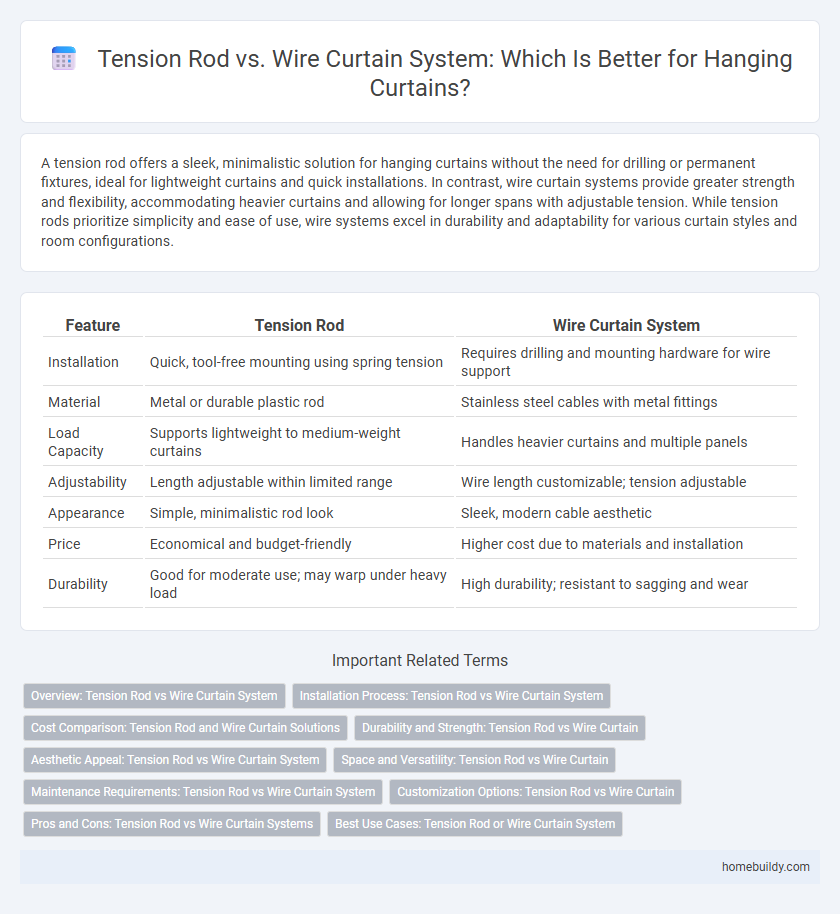A tension rod offers a sleek, minimalistic solution for hanging curtains without the need for drilling or permanent fixtures, ideal for lightweight curtains and quick installations. In contrast, wire curtain systems provide greater strength and flexibility, accommodating heavier curtains and allowing for longer spans with adjustable tension. While tension rods prioritize simplicity and ease of use, wire systems excel in durability and adaptability for various curtain styles and room configurations.
Table of Comparison
| Feature | Tension Rod | Wire Curtain System |
|---|---|---|
| Installation | Quick, tool-free mounting using spring tension | Requires drilling and mounting hardware for wire support |
| Material | Metal or durable plastic rod | Stainless steel cables with metal fittings |
| Load Capacity | Supports lightweight to medium-weight curtains | Handles heavier curtains and multiple panels |
| Adjustability | Length adjustable within limited range | Wire length customizable; tension adjustable |
| Appearance | Simple, minimalistic rod look | Sleek, modern cable aesthetic |
| Price | Economical and budget-friendly | Higher cost due to materials and installation |
| Durability | Good for moderate use; may warp under heavy load | High durability; resistant to sagging and wear |
Overview: Tension Rod vs Wire Curtain System
Tension rods offer a sturdy and adjustable solution for hanging curtains, utilizing spring-loaded mechanisms to maintain tautness without additional hardware. Wire curtain systems provide a minimalist aesthetic through flexible, cable-based suspension, ideal for lightweight fabrics and modern interiors. While tension rods emphasize strength and ease of installation, wire curtain systems prioritize sleek design and versatility in curtain placement.
Installation Process: Tension Rod vs Wire Curtain System
Tension rod installation requires minimal tools, often involving simply measuring, cutting to length, and mounting via adjustable end caps that fit snugly between walls. Wire curtain systems demand more complex steps, including securing wall-mounted brackets, threading wire cables, and attaching curtains with hooks or clips, which generally takes more time and precision. The straightforward setup of tension rods suits quick, temporary solutions, whereas wire curtain systems provide customizable, sturdy installations for long-term use.
Cost Comparison: Tension Rod and Wire Curtain Solutions
Tension rods generally offer a more cost-effective solution compared to wire curtain systems due to lower material and installation expenses. Wire curtain systems often require specialized hardware and professional installation, increasing overall project costs. For budget-conscious projects, tension rods provide a practical alternative without compromising durability and functionality.
Durability and Strength: Tension Rod vs Wire Curtain
Tension rods offer superior durability and strength due to their robust metal construction, typically made from stainless steel or aluminum, which withstands heavy loads and prolonged use without bending or sagging. Wire curtain systems, while flexible and lightweight, generally lack the same tensile strength and may experience stretching or deformation over time under constant tension. The solid and rigid nature of tension rods ensures a more stable and lasting support solution compared to the more elastic wire curtain systems.
Aesthetic Appeal: Tension Rod vs Wire Curtain System
Tension rods offer a sleek and minimalist aesthetic that blends seamlessly with various interior styles, enhancing the visual appeal without drawing excessive attention. Wire curtain systems provide a more industrial and contemporary look, often emphasizing the hardware as a design feature rather than concealing it. The choice between tension rods and wire curtain systems depends on the desired balance between subtlety and bold structural elements in the space.
Space and Versatility: Tension Rod vs Wire Curtain
Tension rods offer superior space efficiency by requiring minimal installation depth, making them ideal for compact areas, while wire curtain systems demand more room due to their track and wire components. Versatility in tension rods allows for easy adjustments and compatibility with various curtain styles and weights, contrasting with wire curtain systems that are better suited for lightweight fabrics and decorative purposes. The tension rod's adaptability to different widths and mounting surfaces enhances functional use, whereas wire systems focus more on aesthetic display and multi-panel arrangements.
Maintenance Requirements: Tension Rod vs Wire Curtain System
Tension rods require minimal maintenance, primarily involving periodic checks for secure mounting and tension adjustments to ensure stability. Wire curtain systems demand more frequent upkeep due to potential wire fraying, tension loss, and the need for hardware lubrication to maintain smooth operation. Overall, tension rods offer a lower-maintenance solution compared to the wire curtain system, which can incur higher costs and effort in long-term upkeep.
Customization Options: Tension Rod vs Wire Curtain
Tension rods offer extensive customization options with adjustable lengths, multiple finishes, and a variety of end caps, making them ideal for precise fit and aesthetic preferences. Wire curtain systems provide flexibility through modular components, allowing for easy expansion and design variations, but often require additional hardware for customization. Both systems support tailored window treatments, yet tension rods excel in simplicity and direct adjustment while wire systems emphasize versatility for complex installations.
Pros and Cons: Tension Rod vs Wire Curtain Systems
Tension rods offer easy installation and adjustable tension, making them ideal for lightweight or temporary curtain setups, but they may lack the durability and sleekness of wire curtain systems. Wire curtain systems provide a modern aesthetic with high strength and flexibility for heavier or multiple curtain panels, though they require more complex installation and can be less adjustable once set. Choosing between tension rods and wire curtain systems depends on factors like curtain weight, desired look, and installation complexity.
Best Use Cases: Tension Rod or Wire Curtain System
Tension rods excel in lightweight applications such as curtains for small windows, shower curtains, or temporary room dividers, providing easy installation without drilling. Wire curtain systems are ideal for heavier fabrics, large window spans, or commercial environments requiring durable, adjustable support with minimal visual impact. Selecting between the two depends on load capacity, installation environment, and aesthetic preferences.
tension rod vs wire curtain system Infographic

 homebuildy.com
homebuildy.com